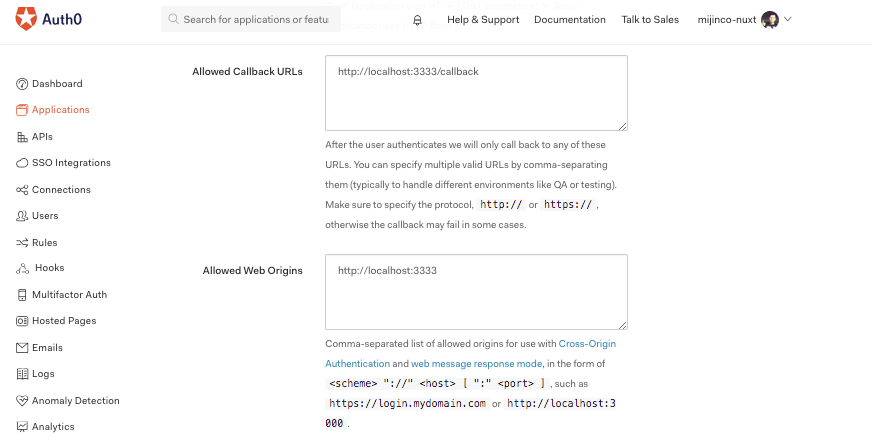おさらい
前回の記事でNuxtの準備ができました。続きを作っていきます。
Nuxtにauth0を組み込む
今回はauth0-Lockというライブラリを使用します。
実行コマンド
yarn add auth0-lock
実行結果
(node:4746) [DEP0005] DeprecationWarning: Buffer() is deprecated due to security and usability issues. Please use the Buffer.alloc(), Buffer.allocUnsafe(), or Buffer.from() methods instead.
[1/4] 🔍 Resolving packages...
[2/4] 🚚 Fetching packages...
[3/4] 🔗 Linking dependencies...
[4/4] 📃 Building fresh packages...
success Saved lockfile.
success Saved 28 new dependencies.
info Direct dependencies
└─ auth0-lock@11.7.2
info All dependencies
├─ asap@2.0.6
├─ ~~中略~~
└─ winchan@0.2.0
✨ Done in 32.76s.
auth0-Lockを利用する
auth0-Lockを利用するために
Nuxtプラグインとしてplugins/auth0.jsにAuth0Utilクラスを実装する必要があります。
その際にauth0で設定したDomainとClientIDが必要になります。
Domain及びClientIDは上記の画像のように
auth0のダッシュボード > Applications > Nuxt(作成したアプリケーション) > Settings
で確認できます。
plugins/auth0.jsを実装する前に
auth0.jsにclientID等をハードコードするのは避けたいので、環境変数から取得することします。
auth0Domainとauth0ClientIDという環境変数を登録する。
.bashrcに登録する場合
vi ~/.bashrc
# 以下二行を.bashrcに追加
export auth0ClientID=********************
export auth0Domain=**********************
# :wqで保存後、以下を実行するかターミナルを再起動させる。
source ~/.bashrc
環境変数を取得
nuxt.config.jsに以下を追加
env: {
auth0ClientID: process.env.auth0ClientID,
auth0Domain: process.env.auth0Domain
}
plugins/auth0.jsの実装
auth0.js
import Auth0Lock from 'auth0-lock'
//環境変数に登録したDomainとClinentIDをenvから取得
const config = {
clientID: process.env.auth0ClientID,
domain: process.env.auth0Domain
}
class Auth0Util {
showLock(container) {
const lock = new Auth0Lock(
config.clientID,
config.domain,
{
container,
closable: false,
auth: {
responseType: 'token id_token',
redirectUrl: this.getBaseUrl() + '/callback',
params: {
scope: 'openid profile email'
}
}
})
lock.show()
}
getBaseUrl() {
return `${window.location.protocol}//${window.location.host}`
}
}
export default (context, inject) => {
inject('auth0', new Auth0Util);
}
nuxt.config.jsにpluginsを追加
nuxt.config.js
mode: 'spa',
plugins: ['~/plugins/auth0.js'] //追加
injectを利用することでVueコンポーネント内でthis.$auth0経由で呼び出しができるようになります。
Loginページを作成
login.vue
<template>
<div id="show-auth"/>
</template>
<script>
export default {
mounted() {
this.$auth0.showLock("show-auth");
}
};
</script>
<style scoped>
#show-auth {
margin-top: 20px;
}
</style>
callbackページを作成
callback.vue
<template>
<p>Signing in...</p>
</template>
callback URLを許可する
AllowedCallbackURLsに追加
http://localhost:3333/callback
AllowedWebOriginsに追加
http://localhost:3333
まとめ
ここまでauth0を利用してgoogleでユーザ認証ができるようになりました。
次回はSpringとauth0を使用してサーバサイドを構築します。

